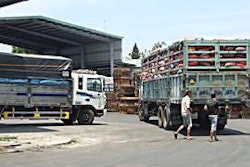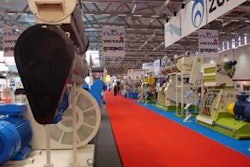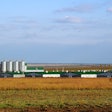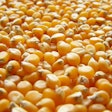
Feed manufacturers are constantly monitoring incoming feed ingredients for a wide range of contaminants and toxic substances. Established limits for a number of compounds and decades of improvements in testing methods make it easy for companies to evaluate everyday variables in buying grain and protein sources.
However, a number of possible contaminants have been tougher to follow with regularity or have not been followed as closely as they might have been. Weed seeds are a common contaminant that may go unnoticed if not considered in assessing incoming feed ingredient samples. A routine feed microscopy monitoring program is an excellent way to screen for weed seeds along with more routine feed analysis.
Recent corn samples received at Auburn University for a nutritional trial showed significant weed seed contamination in 50 percent of the samples (4/8). Although this is an admittedly low sample from which to make inferences, it does indicate that weed seeds may be a more common contaminant than we think. If weed seed contamination is confirmed, future grain deliveries may be rejected or blended to reduce negative weed seed effects. What follows is a guide that may help feed mills in identifying these toxic weed seeds.
Overview
A number of weed seeds commonly found in grains and other feed ingredients have been shown to influence poultry health and productivity. The only weed seeds commonly considered in federal grain trading standards are rattlebox or showy crotalaria (Crotalaria spectabilis), cocklebur (Xanthium strumarium) and castorbean (Ricinus Communis). Other weed seeds that may show up in feeds in sufficient quantities to cause productions losses include coffeeweed or sicklepod (Senna obtusifolia), velvetleaf (Abutilon theophrasti), jimsonweed (Datura stramonium), coffee senna (Senna occidentalis), wild radish (Raphanus raphanistrum) and hemp sesbania (Sesbania exaltata).
Rattlebox (Showy crotalaria)
The most common crotalaria species found in harvested grains and soybeans is showy crotalaria or rattlebox (Picture 1). Seeds of this species are shiny black colored, have a distinctive heart or kidney bean shape and are small (approximately 1/8 of an inch long). Experimentally, feed contaminations above 1 lb/ton (0.05 percent) led to liver damage and abdominal fluid accumulation in the body cavity of broilers. The birds appeared droopy and huddled. Hens lost egg production quickly and showed liver damage. Rattlebox is a common weed seed contaminant and should be considered if weed seed contamination is suspected associated with a poultry production problem.
Sunn hemp
Sunn hemp is a related species to rattlebox and is being promoted as a green manure and ground cover in some areas. This plant has similar looking seeds, but they are much larger (3/8- to 1/4-inch long) and are a dull grayish-black color (Picture 2). The toxic compounds seen with rattlebox are drastically reduced with sunn hemp and should not be a problem unless at a very high concentration in grain. Research at Auburn University has indicated that high feed inclusion levels of sunn hemp (100 lbs/ton, 5 percent) may reduce growth in broilers, although normal contaminant levels (10 lbs/ton, 0.50 percent) will not. Identifying seed contamination between these species may be a problem as rattlebox and sunn hemp seeds may look similar in shape (if not in size and color).
Coffeeweed (sicklepod)
This is a common corn and soybean contaminant in the Southeast (Picture 3). Seeds of this plant are reddish-brown and shaped like a short penne pasta noodle. They are approximately 1/8-inch long. The sickle-shaped seed pods are occasionally found in grains as well. Coffeeweed reduces feed consumption in birds and this may be a major cause of production losses due to feed contamination with this weed seed. Concentrations of 20-40 lbs/ton (1-2 percent) showed reduced body weight in broilers and lower egg production in hens.
Coffee senna
Coffee senna is related to coffeeweed and also has long seed pods (more flattened that in coffeeweed). Seeds are a similar size to those of coffeeweed (1/8 inch), but are teardrop-shaped and dark reddish-black in color (Picture 4). Coffee senna seed concentrations in feed of 40 lbs/ton (2 percent) caused listlessness, diarrhea, muscle paleness and death in commercial poultry.
Jimsonweed
Seeds of this weed species are dark brown, generally round but with a rough seed coat (Picture 5). Rates up to 5,000 seeds per pound have been recorded in corn screening samples. High rates of jimsonweed inclusion have shown eye abnormalities (abnormal contraction of the pupil), excitability and muscle tremors in poultry. High concentrations of jimsonweed (60 lbs/ton, 3 percent) fed for several weeks did not affect production of laying hens or broilers, although feed consumption was reduced in hens. In broilers (0-3 weeks), 1 percent jimsonweed (20 lbs/ton) reduced growth, while 3 percent or more substantially increased feed conversion ratio.
Sesbania
This species originated in Mexico and is a common grain contaminant in the Southeast. Seeds of sesbania are small (1/8 inch), brown, and capsule-shaped (Picture 6). Commercial poultry show reduced feed consumption and growth at high levels (1-3 percent, 20-60 lbs/ton) for broilers and hens, respectively. Wild birds show more tolerance and sesbania is a commonly-used food source for bobwhite quail.
Velvetleaf
Velvetleaf seeds are small and heart-shaped (Picture 7). They closely resemble rattlebox seeds, although they are smaller and lighter in color. Velvetleaf seed contamination as low as 2 lbs/ton (0.10 percent) of finished feed reduced egg production in laying hens and caused yolk quality changes. The most obvious contamination problem with velvetleaf appears to be interior egg quality changes with increased yolk viscosity and deterioration of the yolk membrane during storage.
Wild radish
These seeds are round to egg-shaped and are not flattened as are many weed seeds. They are approximately 1/8 of an inch long and are light to medium brown in color (Picture 8). Wild radish seed contamination reduced egg size from young laying hens and interior egg quality (haugh units) was reduced with high levels of contamination.
Cocklebur
Cockleburs are large (1/2 inch) football-shaped seeds with spiny exteriors (Picture 9). Frequently, the spines are worn down in grain handling so that they appear as nubs only. Although cockleburs cause problems in mammals, including excitability and blindness in cattle, sheep and pigs, poultry appear to be more resistant and no ill effects were noted at reasonable contamination levels.














